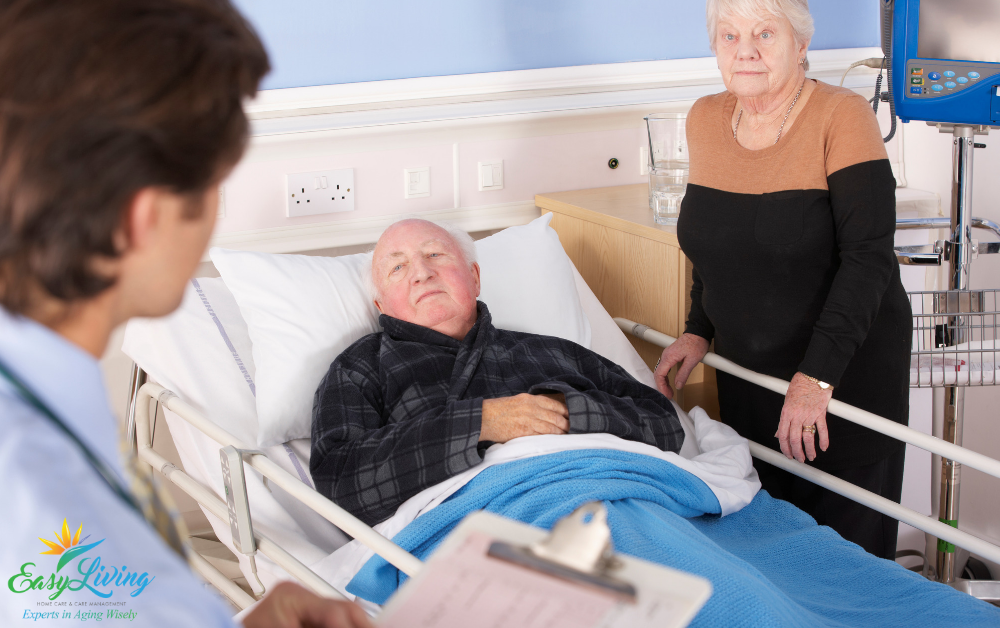Discharge from Hospital: What Goes Wrong
One in five elderly patients is readmitted to the hospital within one month of discharge from hospital. And, studies indicate that these hospital readmissions are avoidable in up to 75% of cases. So, it’s not just that people are ill or problems reoccur. But, clearly things are going wrong in the actual process of discharge from hospital.
The Transition Danger Zone
The first 24-48 hours after discharge from hospital is the “danger zone”. When a patient leaves the hospital, they’re often weakened and quite ill. We all know that hospital lengths of stay can be surprisingly short. While the hospital serves the acute care needs, there’s a gap in services to form a continuum of care.
Patients and families are often caught off guard. They expect that the doctor and hospital staff know what they need. However, the system doesn’t provide care continuity. The doctor typically sees you in the hospital only. The staff creating your discharge plan never observes your home environment. They may not be aware of the challenges you’ll face transitioning home.
For example, they’ll order the equipment you might need. But, then you find out it won’t be delivered until a day or two later. Or, no one considers that someone has been helping you in and out of bed and to the toilet at the hospital. They may arrange post-hospital home healthcare for your medical needs. Meanwhile, such “custodial” needs could cause falls, incontinence or infections. Even if a family member is there to help, they can be overwhelmed. Often, the non-medical support you need to stay healthy gets overlooked in the hospital’s discharge plan.
Missing Follow-up Care
Many patients are unprepared for dealing with their recuperation at home. Studies have indicated that about half of readmissions are linked to lack of community services/follow-up care. For patients age 85+, more than half require assistance with daily needs after a hospitalization. One study indicated that patients who lived alone and did not receive home care services were twice as likely to be readmitted as those who received such services.
Discharge Support Solutions
Transitions of Care
Always consider setting up support for returning home. You can arrange this through a home care company in your area. It’s likely you’ll have to ask about this as it’s infrequently part of the discharge plan. You might want to contact a care manager to provide a holistic plan and continuity of care after discharge from hospital.
As an example, EasyLiving offers a Transitions of Care program. It is a basic 3-4 hour package to get you home safely. It includes:
- Meeting you at the hospital or rehabilitation facility and help getting you and your belongings/equipment safely in and out of the car
- Providing transportation in a private car and getting you settled comfortably at home
- Picking up prescriptions, supplies and equipment
- Going to the grocery store, checking the refrigerator for spoiled food, and putting away your groceries
- Preparing a meal
- Making the bed with clean linens
- Doing a load of laundry
Even clients with a family caregiver can benefit. Just getting an exhausted patient in and out of the car can be taxing. It can even be unsafe for someone without training. And, you may need one person to stay with you while the other does tasks like getting supplies.
Most people can also benefit from extending services to the first 24-48 hours. This reduces the uncertainty by having support when you’re most in need. It gives you time to see how you are managing. You can then determine if you need further assistance.
The Role of Non-medical Support in Recovery
Unfortunately, hospital discharge planning tends to be limited in its scope. Recovering from a hospitalization requires more than just medical care. Patients need safety support, good personal care/hygiene, nutrition and hydration, and help with activities. Additionally, most patients leave the hospital with a new medication regime which may be difficult to follow. And, they usually need to monitor symptoms and follow other treatment protocols.
While discharge planning often includes physical therapy or nursing services, it rarely addresses all the other recovery needs. This can cause problems for any patient, but especially the elderly patient who often has more conditions and is frailer.
The evidence is clear. Studies have indicated that patients who live alone and did not receive home care services were twice as likely to be readmitted as those who received in-home care services. Home care services can be tailored to the individual’s needs after discharge from hospital. And, they can evolve as needs change. They might include:
Nutrition Services/Meal Preparation
The caregiver can do everything from meal planning to grocery shopping and preparing meals. He/she can make meals ahead of time to freeze or prepare and serve meals during visits. Nutrient-dense meals, snack and proper hydration make a huge difference in recuperation. Some patients also need special diets or foods they can tolerate if feeling unwell. A fresh, home-cooked meal goes a long way to making you feel better.
Medication Management, Monitoring Symptoms and Treatments
Medication problems cause somewhere between 20-35% of hospital readmissions. About one in five elderly patients experience an “adverse event” within three weeks of discharge from hospital. And, most of these are preventable or can be easily addressed. However, someone needs to know what to watch for, spot the problem, and communicate with providers. This is where having a caregiver assisting and observing can make all the difference.
Safety Support and Getting Stronger
As you start to recover and perhaps do physical therapy, you’ll begin to gain strength. In the meantime, you remain at high risk for injury. Falls are another significant cause of readmission, especially for patients who were originally hospitalized due to a fall. Fall prevention, unfortunately, plays little role in typical discharge planning. However, you can take action to mitigate risks with a home assessment and minor modifications. This will also identify where you might need extra support during recovery, such as help with bathing.
Your caregiver can also help you get regular exercise (as appropriate) to continue getting stronger. He/she can encourage you to do follow-up exercises your therapist gives you. If you’re feeling unsteady, you’ll be reassured that someone is by your side.
Get a copy of our free Hospital Discharge Planning Checklist. And, contact us for help with making a safe transition home:








